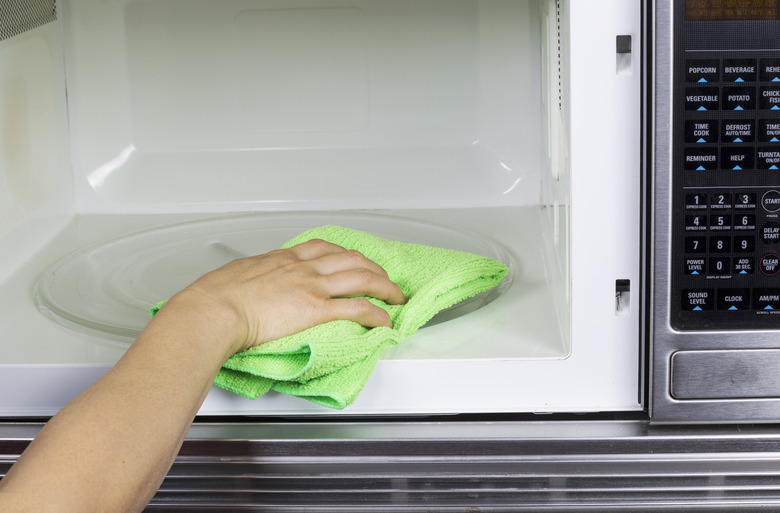How Do I Clean A Stainless Steel Microwave Interior?
If the kitchen gods haven't yet blessed you with a self-cleaning microwave, you'll need to do the job yourself upon occasion. It's easiest and most sanitary to clean up spills or debris from an unfortunate food explosion as soon as they happen. Barring these issues, Cooking Light recommends cleaning the inside of your microwave at least once a month. Frequent users may need to clean their appliances a bit more often.
Read more: How Often You Really Need to Clean Everything in Your Home (Follow This Easy Schedule)
The First Steps
The First Steps
Because safety is always the first concern, unplug your microwave before you begin cleaning it. Once you have, remove the glass turntable and all of its associated parts. Wash these thoroughly in a sink full of soapy water or, if approved by the manufacturer, in the dishwasher.
The next step to cleaning a stainless steel microwave inside is to wash the entire interior down with a damp cloth or sponge. If you notice greasy stains and splatters, you can use soapy water to cut through them. After you do, rinse the area with a soap-free sponge. Although you should never use abrasive cleansers or cloths, you can use a nylon scrubber if you encounter tough stains.
If your microwave now looks shiny and smells fresh, you're all done cleaning. If, however, you're microwave has a funky smell or still contains some food splatters, it's time to move to the next step.
Working Up a Steam
Working Up a Steam
As is true when you clean inside a convection oven or traditional oven, stuck-on food is easier to remove when it's hot. To heat things up and get a steam-cleaning boost, General Electric suggests placing 1 cup of water inside your microwave and cooking it on high for three minutes or until it comes to a vigorous boil. Let the cup sit in the microwave for an additional 5 minutes after it boils.
Now that the steam from the boiling water has loosened things up a bit, wipe down the microwave again with a damp or soapy sponge. Stubborn food particles that resisted your earlier cleaning efforts should now come off much more easily.
Cleaning the Microwave With Vinegar
Cleaning the Microwave With Vinegar
Even a sparkling clean microwave can hold onto smells like burnt popcorn or spicy food. If your microwave smells funky, mix equal parts vinegar and water. Microwave the mixture on high for five minutes and then let it sit inside the microwave for another three minutes. You can also make a paste out of vinegar and baking soda and use it to wipe down the inside of your appliance.
If the smell of vinegar isn't your thing, cut two lemons into wedges and then squeeze the juice into a bowl. Add a cup or two of water to the bowl and then drop the juiced lemon wedges in. Once again, microwave the lemon water on high for five minutes and then let it sit for a few more.
Read more: 19 Ways Vinegar Can Clean Your Home, One Room at a Time
Tips and Warnings
Tips and Warnings
When cleaning the inside of your microwave, always dip the sponge into the water or cleaning solution. Never spritz the microwave with a spray bottle as this can force liquid into the vents. These vents are actually called waveguide covers and they're the place where the microwaves come out of the appliance. Always handle them with care and avoid saturating them.
If it's been a while since your microwave's last cleaning and the food is really stuck, you can use a plastic scraper to remove it. Avoid sharp utensils, however, and don't use the scrubby side of your kitchen sink sponge.
While you're cleaning the inside of the appliance, remember to run a damp cloth around the rubber seal on the microwave's door. This seal is hidden when the door closes, making it easy to forget about when you wipe down the exterior of your appliance. Make sure you clean it now, as the rubber pleats can harbor dirt and bacteria you don't want near your food.
